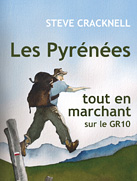One of the earliest rewilding initiatives – and by far the most successful – was the work of two locals, Antoine Knobel and Jean-Marie Sabatut, and an avid hunter. The Pyrenean marmot woke up from its ten-thousand-year hibernation on 15 May 1948, in the Barrada valley near Gavarnie. There are now ten thousand marmots gamboling in the prairies above 1400m.
The marmot’s warning whistle has become, like the tinkling of sheep bells, an audible emblem of the mountains. Guided by the sound, walkers’ heads turn to catch a fleeting glimpse of a nose in the air, swiftly followed by the sight a tail disappearing down a burrow. In the more frequented areas of the mountains, marmots can be observed at close quarters. Near Gavarnie, the less timid ones will demand a toll.
Although marmots had died out in the Pyrenees before the last Ice Age, they were still flourishing in the Alps. Knobel and Sabatut, who had sought the advice of the Forestry Service, recruited the help of Marcel Couturier, our avid hunter, who was based in Grenoble in the Alps.
Back then, the boundaries between hunting and conservation were quite different. Couturier could square the idea of massacring wild animals with the concept of creating National Parks to protect them from hunters. On the negative side, he killed over five hundred chamois. He hunted ibex when the population was still fragile. And he killed one of the last Pyrenean bears. But then again, he was one of the instigators of the Vanoise National Park. And he wrote what were the first reference books on the Alpine ibex and the Pyrenean bear. Crucially for the reintroductions, he had a hunting permit that allowed him to capture any animal he wanted for his researches. (Just to be clear, marmots are not hunted, though apparently edible.)
The result of the collaboration was that six 20th-century marmots, literally deeply asleep, were dug out of their burrows in November 1947. They passed the winter in a storeroom before being released.
Impact studies? Who knows? But since then, we have learnt that marmots are good news for golden eagles and foxes. Bad news for rare flora. And they have little effect on rock ptarmigan or pastures, despite chomping their way through 100kg of vegetation annually.
Meanwhile, the initiatives continued, and four hundred more marmots went to sleep in the Alps and woke up in a world that looked strangely familiar but subtly different










Footprints on the mountains